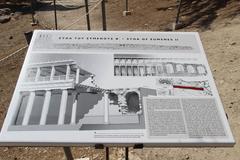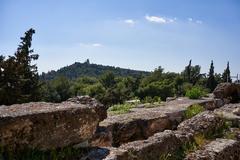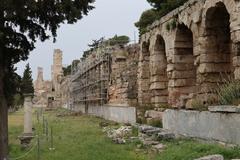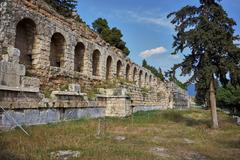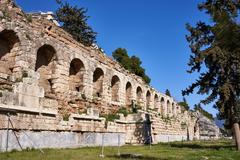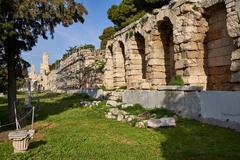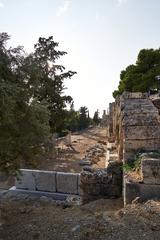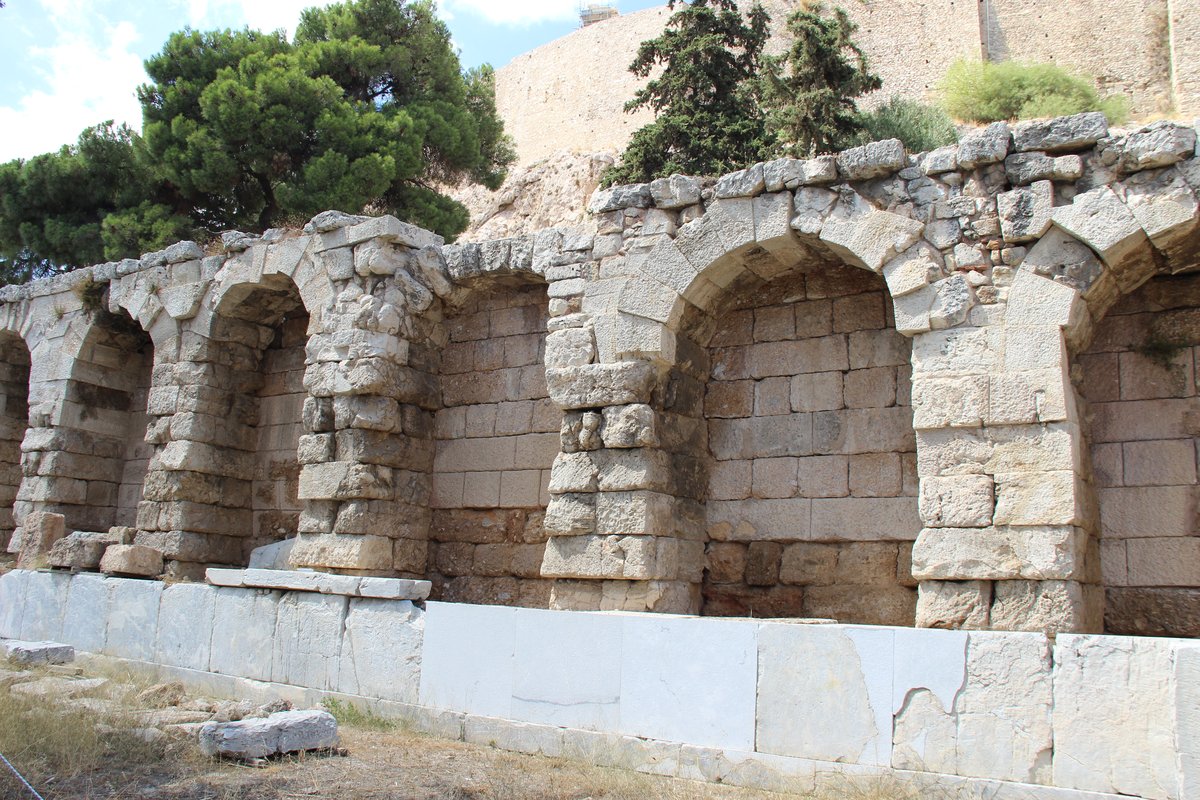
Stoa of Eumenes, Athens, Greece: Visiting Hours, Tickets, and Travel Guide
Date: 03/07/2025
Introduction
The Stoa of Eumenes is a striking relic of Hellenistic Athens, located on the southern slope of the Acropolis. This monumental two-story colonnade, commissioned in the 2nd century BCE by King Eumenes II of Pergamon, served both as a diplomatic gift and as a testament to the flourishing ties between Athens and Pergamon. Today, the stoa’s ruins provide invaluable insights into ancient urban planning, architecture, and public life, making it a must-visit for anyone interested in classical history or architecture. This guide provides detailed information on the stoa’s history, practical visiting details, and travel tips to help you make the most of your visit.
Table of Contents
- Historical Background
- Visiting Information
- Frequently Asked Questions (FAQ)
- Practical Tips for Visiting
- Conclusion
- References
Historical Background
Origins and Patronage
Commissioned around 160 BCE by Eumenes II, king of Pergamon, the Stoa of Eumenes was both a political gesture and a cultural bridge between two leading Hellenistic powers. Eumenes II, known for his patronage of the arts and architecture, intended the stoa as a public amenity and as a symbol of Pergamon’s sophistication. Its placement between the Theater of Dionysus and the Odeon of Herodes Atticus highlighted Athens’ status as a cultural and performance hub (Everything.Explained.Today; Korres, 2022).
Architectural Design and Construction
Site and Layout:
The stoa was constructed on a large artificial terrace supported by an impressive arched retaining wall. Stretching approximately 163 meters in length and around 17 meters in width, it was a two-story structure adorned with a mix of Doric, Ionic, and Pergamene-style columns. The use of imported Prokonnesian marble and prefabricated architectural elements reflects both the technical prowess and the logistical capabilities of the Hellenistic age (Korres, 2022).
Materials and Techniques:
The stoa’s construction involved both local materials and marble shipped from Pergamon. Many structural elements were prefabricated and marked with mason’s letters for efficient assembly—a testament to the era’s advanced building methods (Korres, 2022, p. 64).
Connectivity:
Designed to serve theatergoers, the stoa’s ground floor could be accessed via the western parodos of the theater. Two external staircases connected the levels, providing shelter and easy movement for large crowds (Everything.Explained.Today).
Function and Role in Ancient Athens
The stoa functioned as a sheltered promenade and gathering space for visitors to the Theater of Dionysus and participants in religious festivals. It likely hosted philosophical discussions, commercial activities, and served as a backstage area for theatrical performances. The grand design reinforced Athens’ cultural and cosmopolitan identity during the Hellenistic period (BMCR, 2025).
Later History and Transformations
In the Roman era, a staircase connected the stoa to the Odeon of Herodes Atticus, further integrating the area’s theater complex. The building remained in use until the 3rd century CE, after which it was damaged, and some materials were reused in fortifications. In the Byzantine period, parts of the stoa’s retaining wall were incorporated into the Rizokastro Wall (Everything.Explained.Today). Excavations in the late 19th century uncovered much of what is visible today.
Visiting Information
Opening Hours
- Summer (April to October): 8:00 AM – 8:00 PM
- Winter (November to March): 8:00 AM – 5:00 PM
Hours may vary seasonally or due to special events. Always check the Acropolis Museum website or the Greek Ministry of Culture for up-to-date information.
Tickets and Admission
- Stoa access is included with the Acropolis archaeological site ticket.
- April to October: €30
- November to March: €15
- Free admission on select days: March 6, April 18, May 18, last weekend of September, October 28, and first Sunday of each month from November to March (Ancient Greece Wanderings)
- Reduced prices are available for EU citizens under 25; children under 18 and seniors over 65 may be eligible for free or discounted entry.
- Purchase tickets in advance at the official Acropolis ticket website to avoid long queues.
Accessibility
The Acropolis site features uneven terrain and slopes, particularly on the southern slope where the stoa is situated. Some pathways are accessible, but full exploration may be challenging for those with mobility impairments. Wheelchair access is available at the main Acropolis entrance, but may not extend throughout the southern area (Ancient Greece Wanderings).
Getting There
- On Foot:
15–20 minutes’ walk from Syntagma Square or the Plaka district. - By Metro:
Red Line 2 to Akropoli station, then a 10-minute walk following signs to the Acropolis and Theater of Dionysus. - By Bus:
Bus line 230, disembark at “Akropoli” stop on Dionysiou Areopagitou Street. - By Car:
Limited parking near the Acropolis Museum or Plaka. Early arrival is advised (Greeka; Evendo).
Nearby Attractions and Amenities
- Theatre of Dionysus: Adjacent to the stoa, the world’s first theater.
- Odeon of Herodes Atticus: Still used for performances, a short walk to the west.
- Acropolis and Parthenon: A brief uphill walk to the iconic citadel.
- Asklepieion: Located just above the stoa.
- Cafés and restaurants are plentiful in the nearby Plaka and Makrygianni neighborhoods.
Tips for Visitors
- Visit early in the morning or late afternoon for cooler temperatures and fewer crowds.
- Wear comfortable walking shoes and bring water, especially in summer.
- Guided tours are available and recommended for deeper insight.
- Respect the site by not climbing on ruins or removing stones.
Frequently Asked Questions (FAQ)
Q: What are the opening hours for the Stoa of Eumenes?
A: The stoa is open during Acropolis site hours: 8:00 AM to 8:00 PM in summer, 8:00 AM to 5:00 PM in winter.
Q: Is there a separate ticket for the Stoa of Eumenes?
A: No, entry is included in the Acropolis archaeological site ticket.
Q: Is the Stoa of Eumenes wheelchair accessible?
A: The main Acropolis entrance is accessible, but the southern slope where the stoa is located has uneven terrain and stairs, which may be challenging.
Q: Are guided tours available?
A: Yes, many Acropolis tours include the stoa.
Q: Can I take photographs?
A: Photography is allowed, but the use of tripods may require special permission.
Practical Tips for Visiting
- Best time to visit: Early morning or late afternoon for ideal lighting and temperature.
- What to bring: Water, sun protection, comfortable shoes, camera.
- Facilities: Restrooms and water fountains at main entrances; food and drink options in nearby neighborhoods.
- Etiquette: Avoid touching or climbing on ruins, and follow posted guidelines to help preserve the site.
Conclusion
The Stoa of Eumenes stands not only as a testament to Hellenistic architecture and the cosmopolitan spirit of ancient Athens but also as a vibrant node in the city’s network of public, civic, and cultural spaces. Its monumental scale, architectural refinement, and strategic location underscore its historical significance and enduring appeal. Today, a visit to the stoa provides a window into the dynamic life of classical Athens, complementing explorations of the Acropolis and surrounding landmarks. For the latest visitor information, refer to official sources such as the Acropolis Museum and make use of digital tools like the Audiala app for an enhanced experience.
References
- Everything.Explained.Today: Visiting the Stoa of Eumenes in Athens: Hours, Tickets, History, and Tips
- Korres, 2022, University of Athens eClass
- BMCR, 2025, Bryn Mawr Classical Review
- Wikipedia: Stoa of Eumenes
- Greeka: Stoa of Eumenes
- Ancient Greece Wanderings: Visiting the Acropolis of Athens
- Evendo: Stoa of Eumenes
- JV Wanderings: Visiting the Acropolis and Parthenon in Athens
- Trek Zone: Stoa of Eumenes
- Lonely Planet: Stoa of Eumenes & Asklepieion
- Around Greece: Stoa of Eumenes

